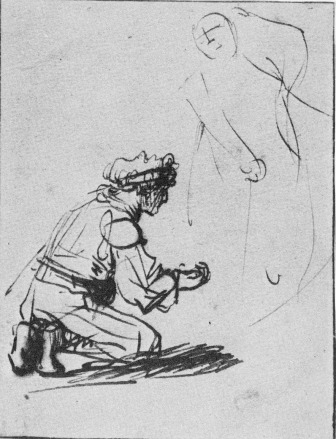
What happened to kneeling?
People have problems, so they call the ambulance. We arrive and find them — mostly — seated in a chair, or lying in a bed, or perhaps down on the ground. Then we kneel beside them and introduce ourselves. We ask questions, put our hands on them, give medicines, and so on down that clinical flow you learned in school.
Here is what we don’t do: stand six feet away, look down at the patient (and maybe, maybe deign to bend over a little, with our hands on our thighs like we’re admiring a gregarious puppy), and shout in their direction. “Do you want to go to the hospital?” This is not yodeling practice. This is caregiving.
When did we stop kneeling? More and more, this practice seems to be spreading, and it’s reached the point where I can hardly remember the last time I saw one of us kneel beside a patient. Occasionally somebody will kneel to take vitals, but the provider actually speaking and interacting with the sick person still towers over them like a cop chalking off a body.
Yes, yes, I get it. Your knees are bad. I’ve been there. And your back, it’s stiff. You’re not 21 anymore, you can’t go kneeling willy-nilly. Sure.
But we’re not talking about an Olympic sport here, okay? We’re talking about kneeling, at least for a moment, in whatever manner you can successfully perform. At the very, very least, sit down on something so you’re level with the patient. Park your butt beside them on the sofa or pull up a chair.
It’s about patient comfort, because they want to feel like they’re engaging with a fellow human, not yelling up at Rapunzel’s tower. But it’s also about the dynamic it creates between you. As a novice provider, when I first read Thom Dick write about humility, I didn’t understand. But as time passed, it made more and more sense to me (something that happens suspiciously often with Thom’s stuff). Body language says something, not just to others, but to yourself.
When you kneel, you’re saying: I’m here to help. I’m here to serve you. We don’t kneel very much anymore, not in the modern Western world, but we understand instinctively why one would kneel before a king. It’s not in spite of the effort it takes you to get down there, it’s because of it: by making yourself uncomfortable, you’re demonstrating a willingness to put someone else’s needs before your own.
It’s not saying that they’re your master, and you’re not making them the boss of anything. They’re not making you kneel, which is all the difference: it’s a gift, freely given. You’re acknowledging that the patient is important. More prosaically, it’s very much like the relationship that the cashier at Wal-Mart is supposed to have with you (at least in theory). If you met him on his day off, he might cut you off in traffic, flip you the finger, and drive away cackling. But while you buy batteries, at least, it’s his job to help you out. If he’s lucky, he enjoys doing that; if he’s not, he feels forced into it because he wants to keep his paycheck. We’re in a different boat, though, because our obligation doesn’t come from a boss looking over our shoulder. It comes from the fact that we accepted a duty (perhaps sacred, perhaps mundane, but a duty either way) — that when someone calls 911 and asks for our help, we’ll come and serve them. That makes us servants, and not in a bad way.
Something different happens when you refuse to lower yourself before a patient. It tells everyone in the room, including the patient and especially including yourself, that although you’re here, and although you might perform the clinically-indicated medical treatment, you’re not putting yourself out at all. Drive-by care is all you’re willing to offer. It’s like telling the patient: “Just to be clear, we were in the area anyway, and I thought you might have some snacks.”
I have great respect for police, and we work alongside them often. But their business is very different from ours, and it highlights the dangers in conflating the role of EMS with that of public safety. The job of a caregiver is to serve. The job of a cop is to enforce. It means they have to elevate themselves — you can’t exert authority unless you’re coming from a place of some kind of superiority (legal, moral, even physical). It means they have to judge. I don’t know if they enjoy it, and I do know that it’s highly necessary. But it takes a different kind of person, or at least a different kind of thinking, to judge people than it takes to serve them. Try to imagine a cop kneeling, or helping to wipe Mrs. Smith’s bottom. Now imagine yourself wearing aviators, crossing your arms and leaning against the wall while you bark at her, and understand that it’s just as misplaced.
What’s funny is that when you accept this “lesser” role, you can find an awful lot of meaning in it, because it’s a privileged place too. The privilege isn’t something you exert over others: rather, it’s freely granted to you by the patient. When they see that you’re here to help them, they give you permission to enter their home, to touch their body, to ask them the most intimate questions. This is essential, because you need that access to do your job (and it’s why I believe that mixing EMS and law enforcement would mean a major blow to our ability to treat people). But it’s still a gift. And I think that’s worth something. Even sore knees.


Recent Comments